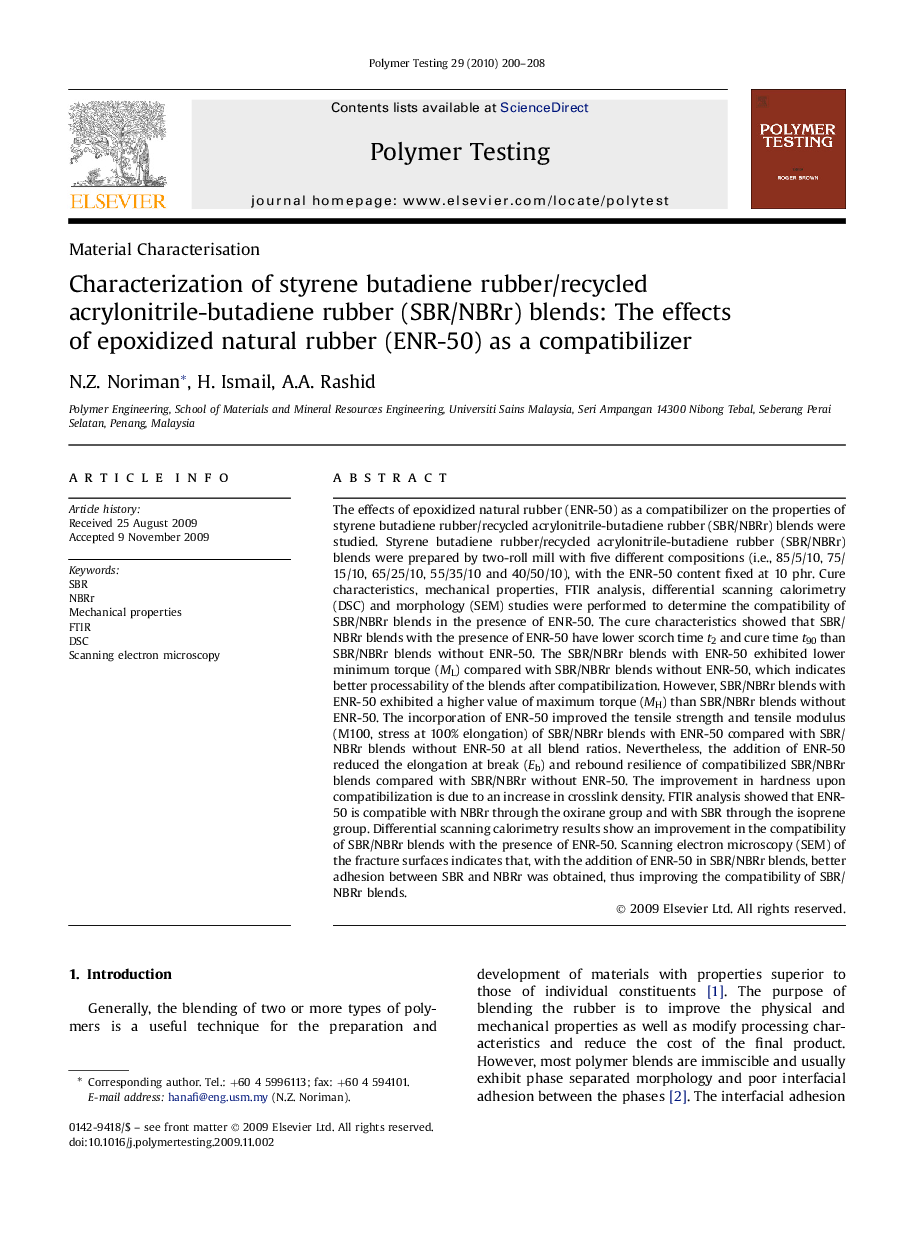| کد مقاله | کد نشریه | سال انتشار | مقاله انگلیسی | نسخه تمام متن |
|---|---|---|---|---|
| 5207163 | 1382338 | 2010 | 9 صفحه PDF | دانلود رایگان |
عنوان انگلیسی مقاله ISI
Characterization of styrene butadiene rubber/recycled acrylonitrile-butadiene rubber (SBR/NBRr) blends: The effects of epoxidized natural rubber (ENR-50) as a compatibilizer
دانلود مقاله + سفارش ترجمه
دانلود مقاله ISI انگلیسی
رایگان برای ایرانیان
کلمات کلیدی
موضوعات مرتبط
مهندسی و علوم پایه
شیمی
شیمی آلی
پیش نمایش صفحه اول مقاله

چکیده انگلیسی
The effects of epoxidized natural rubber (ENR-50) as a compatibilizer on the properties of styrene butadiene rubber/recycled acrylonitrile-butadiene rubber (SBR/NBRr) blends were studied. Styrene butadiene rubber/recycled acrylonitrile-butadiene rubber (SBR/NBRr) blends were prepared by two-roll mill with five different compositions (i.e., 85/5/10, 75/15/10, 65/25/10, 55/35/10 and 40/50/10), with the ENR-50 content fixed at 10Â phr. Cure characteristics, mechanical properties, FTIR analysis, differential scanning calorimetry (DSC) and morphology (SEM) studies were performed to determine the compatibility of SBR/NBRr blends in the presence of ENR-50. The cure characteristics showed that SBR/NBRr blends with the presence of ENR-50 have lower scorch time t2 and cure time t90 than SBR/NBRr blends without ENR-50. The SBR/NBRr blends with ENR-50 exhibited lower minimum torque (ML) compared with SBR/NBRr blends without ENR-50, which indicates better processability of the blends after compatibilization. However, SBR/NBRr blends with ENR-50 exhibited a higher value of maximum torque (MH) than SBR/NBRr blends without ENR-50. The incorporation of ENR-50 improved the tensile strength and tensile modulus (M100, stress at 100% elongation) of SBR/NBRr blends with ENR-50 compared with SBR/NBRr blends without ENR-50 at all blend ratios. Nevertheless, the addition of ENR-50 reduced the elongation at break (Eb) and rebound resilience of compatibilized SBR/NBRr blends compared with SBR/NBRr without ENR-50. The improvement in hardness upon compatibilization is due to an increase in crosslink density. FTIR analysis showed that ENR-50 is compatible with NBRr through the oxirane group and with SBR through the isoprene group. Differential scanning calorimetry results show an improvement in the compatibility of SBR/NBRr blends with the presence of ENR-50. Scanning electron microscopy (SEM) of the fracture surfaces indicates that, with the addition of ENR-50 in SBR/NBRr blends, better adhesion between SBR and NBRr was obtained, thus improving the compatibility of SBR/NBRr blends.
ناشر
Database: Elsevier - ScienceDirect (ساینس دایرکت)
Journal: Polymer Testing - Volume 29, Issue 2, April 2010, Pages 200-208
Journal: Polymer Testing - Volume 29, Issue 2, April 2010, Pages 200-208
نویسندگان
N.Z. Noriman, H. Ismail, A.A. Rashid,